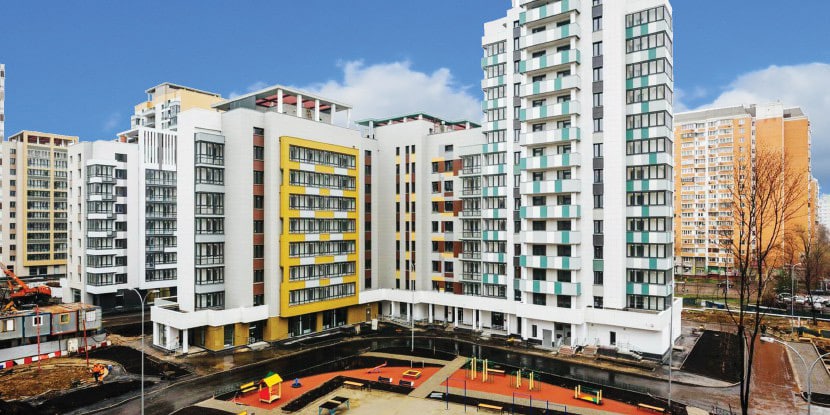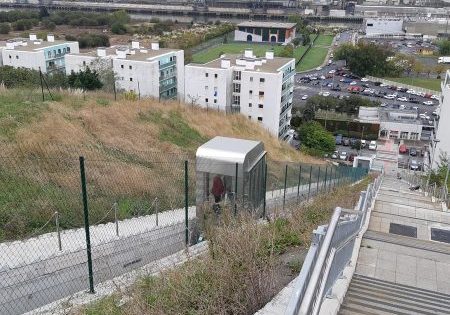Land of Opportunity
Oct 1, 2021

Renewal of outdated housing among factors fueling elevator demand in Russia.
Elevator manufacturers anticipate growth opportunities in the Russian market this year, thanks to ongoing economic recovery from the pandemic and growing demand for elevators locally, according to industry players and analysts. Despite the pandemic and its negative economic impacts, the federal government and regional authorities continue to roll out numerous programs to renew domestic housing stock, which typically leads to massive new elevator orders. Probably the biggest such program — both in volume and value — has been ongoing in the city of Moscow since 2017. Involving resettlement and demolition of dilapidated mid-rise Soviet Era housing stock constructed from 1957-1968, the controversial Moscow Housing Renovation Program involves demolishing 5,800 apartment houses and relocating more than 1.6 million residents.[1] New housing served by elevators is built on the vacated territory. The program is projected to unfold over 15 years.
In general, the elevator industry is one of the few industries in Russia less affected by the pandemic. As of July, it had almost reached pre-pandemic production and revenue figures. This was recently confirmed by some leading local players, many of whom are ready to accelerate expansion in Russia.
Anton Artemiev, general director of the Shcherbinsky Elevator Building Plant, one of the largest builders of elevators in Russia and a division of Dom.RF Corp., tells EW:
“The pandemic had a negative effect on the domestic elevator market only in terms of lockdowns and the disruption of global supply chains. The overall situation in the market remained stable, even during the peak of the pandemic last year, while active construction of housing stimulated the entire market.”
According to Artemiev, ongoing replacement of housing in Russia — particularly in Moscow — may present big opportunities for growth for both domestic and global elevator manufacturers. Replacing obsolete elevator equipment is one of the main types of work involved in overhauling housing stock, he observes. Annual demand is currently at 14,000-19,000 units, he says. As demand for elevators in Russia steadily grows, the Shcherbinsky plant has set an ambitious target to increase output by almost 30% this year and capture up to 26% of the domestic market by 2024.
In addition to domestic players, the market remains on the radar of global OEMs, many of which say they plan to participate in state tenders more actively. For the majority, the Russian market remains one of the most promising in terms of growth potential.
Helmut Brandl, CEO of TK Elevator (TKE) Russia, Eastern Europe, Turkey and Israel, comments:
“We at TK Elevator share the positive outlook on the Russian market for all business lines, including the modernization segment. We are upbeat about the market in general and for ourselves. The renovation of housing stock certainly supports this positivity. With our local product SimplyCity, we have a fully customized offering for this segment. TK Elevator is well prepared for such investments in Russia in this field in the future.”
The Shcherbinsky plant has set an ambitious target to increase output by almost 30% this year and capture up to 26% of the domestic market by 2024.
According to Brandl, Russia is an important market for TKE as the company continues to seize growth opportunities in all lines of business. “Our local presence and customized products support us in this effort,” Brandl says.
Other global OEMs are also optimistic about and active in the Russian market. Igor Mayorov, managing director of Otis Russia, observes the company has approximately 130 years’ experience in and many branches across the country, from Kaliningrad in the west to Khabarovsk in the east. Otis provides a broad range of services — from manufacturing and sales of new equipment to maintenance and modernization of existing units. Mayorov elaborated:
“We also have production facilities in Russia, including our flagship elevator manufacturing plant in St. Petersburg. Otis employs thousands of people in Russia, including more than 1,000 mechanics who maintain equipment and support its continuous, safe operation.
“The Otis portfolio in Russia includes high-speed elevators for high-rise buildings. The OKO Towers in Moscow City, which include the tallest residential building in Europe, together have 58 Otis elevators and CompassPlus destination-dispatch system (ELEVATOR WORLD, March 2021). Additionally, our equipment is used for commercial and infrastructure projects, such as the Bolshoi Theater, the Moscow International House of Music and many Russian airports. Our elevators have been instrumental for several facilities constructed for major international sporting events that took place in Russia in recent years.”
At the same time, most independent analysts expect further tightening of competition in the market, predicting global producers to gain strength as demand for premium elevators in Russia steadily grows.
Pyotr Kharlamov, general director of the Russian Elevator Association, a public association that unites leading domestic elevator manufacturers, commented in an exclusive interview:
“Global elevator manufacturers have good opportunities for work in the Russian market at present, in both the residential and commercial segments. Of course, it is easier for those that have an official representative office here. For example, Otis has both a representative office and its own production plant in the country, which enables the company to regularly participate in many tenders and competitions.
“We expect that the biggest demand for foreign elevators will be in the high-rise building segment, where speed is important. However, a number of nuances affect the final elevator supplier selection of Russian customers, among which are ruble devaluation and sanctions of certain foreign countries, which can be restrictive.”
According to Kharlamov, replacing elevators that have exhausted their standard service life (25 years) usually involves purchasing domestic equipment. This is due to more affordable costs, including for maintenance, and the availability of spare parts. For foreigners, the biggest opportunity for success in residential housing in Russia is supplying elevators for premium and elite housing, the volume of which has also significantly increased in recent years.
Analysts say another important source of elevator demand is the commercial property segment, which by 2024 is expected to grow from 9,000 to 33,000 elevators annually. Another promising niche may involve supplying elevators for medical institutions, particularly hospitals, for which demand for elevators has significantly increased since the start of the pandemic.

Reference
[1] The Moscow Housing Renovation Programme: Responsiveness, Redistribution, and Regime Stability in Russia – 18 March 2019, Kings College of London, Kings Events
Get more of Elevator World. Sign up for our free e-newsletter.









